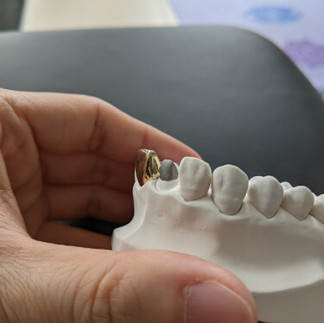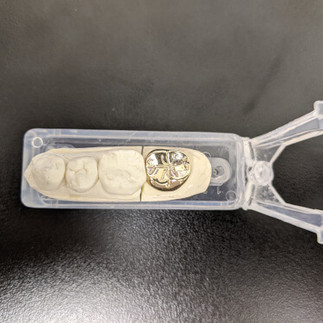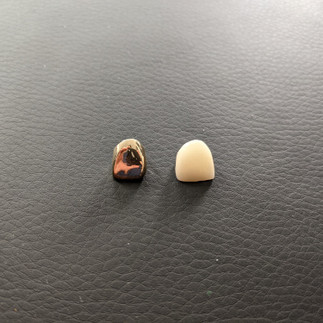Gold Tooth Crown: Things To Know
- David Chen, DDS
- Nov 3, 2023
- 5 min read
Updated: Jan 6, 2024
This is a general guide with pertinent and useful information about gold tooth crowns if you were considering getting one.

At the end of the day it is still a dental crown and functions like one. The main difference is the material that it is made of.
Table of Contents:
Overview
A gold tooth crown is a type of dental crown but it is made of gold instead of porcelain or other types of dental ceramic. It is technically a metal crown but never referred to as such since it is made of a precious metal.

Notable features:
Functionality wise there is no difference because you eat, chew, and speak with it the same way as any other teeth.
Purpose wise is also the same. It is used to change the appearance, restore lost tooth structure, and protects your natural tooth underneath.
Procedure wise is exactly the same as other crowns. The only difference is your dentist checks off gold as crown material of choice in lieu of porcelain.

The biggest defining feature of a gold cap tooth is the yellow appearance that is reminiscent of yellow gold jewelry.

What to expect for procedure
The process to get a gold crown tooth will take a total of two visits. The first appointment will take roughly 45-60 minutes while the second will be 30-45 minutes. You may be numb for both them if your tooth is still vital/alive.
Overview of each appointment:
Visit 1: Tooth preparation and taking an impression (mold of the teeth).
Visit 2: Try in the permanent crown and glue it in permanently.
First appointment
Administer local anesthesia. Numbing gel with Lidocaine injection.
Tooth preparation. Shave down the tooth to fit the new gold cap.
Pack cord. Place a thin cord around the gums to push them down and reveal the prepared margins for a more accurate impression (mold).
Take an impression. Take a mold of the teeth with PVS which gets sent to the dental lab for fabrication of the yellow gold crown.
Fabricate a temporary crown. A temporary crown needs to be made in order to protect the shaved down tooth while you wait for the permanent one. The temporary will be glued in with temporary cement.
Second appointment
Administer local anesthesia. This is only required if you don't have a dead tooth.
Remove temporary crown. You have to take off the temporary to try in the permanent one.
Clean residual cement. Old glue on the tooth may prevent the new one from fitting properly.
Try in the permanent crown. The try-in process is to make sure that it fits before it gets glued in. If it doesn't fit, it will need to be sent back for a do over.
Adjust the crown. If the new cap feels too tight, the contacts need to be adjusted. If the bite feels uneven, the occlusion will need an adjustment. Both of these can be done chairside by your dentist with a fine diamond football bur.
Polish. After all adjustments it is important to polish it so that it doesn't feel rough.
Permanently glue it in. This time permanent glue will be used.
Appearance
Dental gold crowns look similar to other types of crowns (porcelain, ceramic, zirconia, emax, PFM) except that the color is yellow. The shape of the tooth will be identical to other tooth cap materials.
The only difference is that there will be no tooth color or tooth shade option for dental crowns that are gold. There is only one color option and that is yellow by default. The porcelain caps for teeth will allow you to choose a color from the vita shade guide.
Gold front tooth crown
Below are photos of what a front gold tooth looks like:
Gold molar crown
Below are photos of what a back molar gold tooth looks like:
Video
Below is a video showing you 360 degree views of a front tooth gold crown. Seeing it in three dimensions will give you a better perspective of what to expect appearance wise.
Pros & Cons
Gold crown teeth do come with certain advantages and disadvantages but overall, there are more pros than cons.
Pros:
Durability - it can last for decades.
Great fit - the crown margins can be burnished for an impeccable fit.
Biocompatibility - gold is well acceptable by the body and does not cause tissue irritation.
Cons:
Cosmetics - some people refuse to have gold teeth but some rappers love it!
Cost - can be expensive if you need a large crown.
The disadvantages of gold teeth would be the cost and the cosmetics. It costs a lot because it is made of a precious metal and you do get charged for it by weight. The bigger your tooth, the more gold that is needed and the more it'll cost.

Aesthetically, gold teeth doesn't float everyone's boat if you know what I mean. But this could very well be a pro for you if you specifically wanted it.
Gold vs porcelain crowns
Both types of crown materials function and work in the same exact manner but there are differences between them. With the advent of the newer porcelain materials, the trend has been moving away from getting gold teeth. Patients prefer more natural looking restorations.
Attributes | Gold crown | Porcelain crown |
|---|---|---|
Durability | Lasts for decades | 8-10 years |
Cost | More expensive | Less expensive |
Cosmetics | Unnatural looking | Natural looking |
Function | Equal to porcelain | Equal to gold |
Biocompatibility | Very compatible | Very compatible |
Dental glue | Cement only | Cemented or bonded |
Side effects
The only potential side effect of having a gold tooth crown would be if you were allergic to yellow gold. According to one study, roughly 9.5% (388 out of 4101 patients) had a positive allergy skin patch result.
If you're allergic to this material, you should not get any gold restorations placed in your mouth. It will trigger immune reactions.
However, most people will know if they're allergic or not because chances are, they already have gold jewelry. If you're able to wear them, you can expect to have a gold tooth with no problems.
Costs
The average cost of a gold tooth is $1400 and that is without any dental insurance. If you do have insurance, the cost would be $700 and that is based on the average coverage of 50%. Yes, most dental plans will cover all crown procedures including gold ones at 50%.
Dental billing code: D2790
| Average cost | Cost range |
|---|---|---|
Gold crown without insurance | $1400 | $1100-$1900 |
Gold crown with 50% insurance coverage | $700 | $550-$950 |
However, you should be aware that the price of a gold tooth can vary greatly depending on the cost of living in your area. That is why we included a cost range to give you an idea of what a low cost of living vs high cost of living fee would be.
Last but not least, you should also keep in mind that the ultimate cost for a gold tooth cap is that the weight of your crown affects the price. Unlike porcelain crowns where the dental lab will charge your dentist a flat rate fee, gold caps get billed based on their weight.
A bigger or heavier crown will cost more.
A smaller or lighter crown will cost less.
The reason is because the bigger the tooth, the more gold that is required to make it. As you may already know, the price for gold fluctuates greatly since it is traded as a commodity.
Gold vs porcelain crown cost
Below is a table comparing the cost of crowns made from gold and porcelain.
| Gold | Porcelain |
|---|---|---|
Average cost | $1400 | $1300 |
Cost range | $1100-$1900 | $1000-$1700 |
Average price with insurance | $700 | $650 |
Gold tooth implant cost
The cost of a gold tooth implant will differ from a regular tooth cap because you have to factor in the implant abutment cost. Therefore, the total price for the implant version would be the cost of a gold crown plus the implant abutment.
Price breakdown:
Average gold cap price: $1400
Average implant abutment price: $1000
Total cost = $2400
In summary, the average cost of a gold tooth implant without insurance is $2400.
















